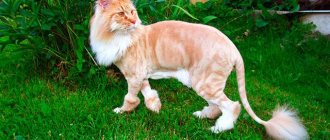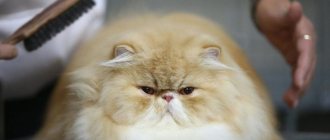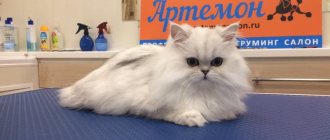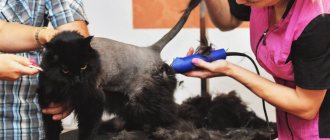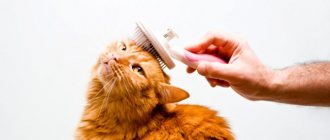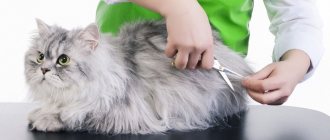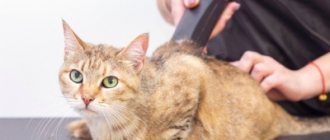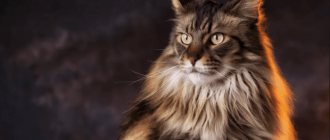It also happens that the animal does not allow itself to be combed - the cat scratches, and the dog tries to bite. You can try to solve the problem yourself by buying the animal a special collar for the neck. But if your pet is aggressive and you can’t cope, it’s better to take him to a veterinarian or groomer.
Be sure to brush long-haired cats and dogs before and after bathing. It is especially important to do this during the molting period - autumn and spring. Animals with fur “pants” on their hind legs need to have their fur trimmed. This is necessary so that nothing sticks when the animal goes to the toilet.
What is grooming and why is it needed?
Cat grooming is a set of procedures, namely: caring for cats' fur and ridding pets of parasites. In other words, a haircut, thanks to which excess pieces of fur are removed, claws are trimmed and the cat is washed. In specialized salons, in addition, masks can be applied for better hygienic treatment.
There are several tools for grooming, namely:
- Colt cutters.
- Massage brushes.
- Combs.
- Hair dryers for hair styling.
- Rotary machines.
- Pukhoderki.
- Furminators.
- Scissors for cutting cats.
- Nail clippers.
- Shampoos.
Caring for a cat's fur plays an important role in his life. If your pet has problems with its fur, such as mats, then you should resort to grooming. It should be remembered that this cannot be neglected and left unattended; tangles and pellets bring discomfort to the cat, which interferes with washing the cat, since the skin under the matted fur takes a long time to dry and quickly becomes inflamed. In addition, the cat needs to be combed regularly; for this, two combs are used: one with sparse teeth, and the other with frequent ones to comb out fleas.
Grooming of cats is also necessary if they have skin-related diseases or are of advanced age. If your pet has ear mites, fleas or dermatitis, the cat should be groomed for better access to the skin. If your pet has excessive hair loss, a haircut should also be performed. Grooming will slow down the growth of nails and reduce the risk of being scratched.
Grooming is also ordered when small children live with the pet. By reducing the amount of fur, the risk of allergies decreases.
Popular cat haircuts
There are two types of haircuts : hygienic and model. Hygienic reasons include matted fur, hot summer weather, skin diseases, older cats, and active glands.
Model haircuts are not a necessity, it is the owner’s personal desire to see the cat well-groomed and beautiful. If you follow fashion, you can get a “Lion” haircut and make your pet look like a real mini-lion. “Puma” and “Dragon” haircuts are in demand. Indeed, there is a similarity with the creatures of the same name.
It is not advisable to have a haircut more than 3 times a year.
Remember that any procedure is stressful for a cat, so unless clearly necessary, you should not include model haircuts in mandatory grooming.
Types of grooming
Grooming a cat's fur can be used for different purposes, and its nature will depend on it.
- Hygienic. This type of grooming aims to make it easier to keep the cat clean. It includes the most common procedures, namely: haircut, washing the pet with shampoo, trimming nails, cleaning eyes and ears.
- Home. This procedure can be carried out either by the owners themselves or by a specialist calling at home. Home grooming differs from hygienic grooming only in that it is carried out at home, in a calmer environment for the pet.
- Exhibition. This type of pet care aims to hide all the shortcomings of the cat and highlight all the good qualities.
When does a cat need professional grooming?
The main feature of professional grooming is the emphasis on cutting the animal’s fur. If your cat needs a haircut, it is better to seek the help of a professional - take your pet to a grooming salon or call a groomer home. A professional groomer knows how to cut a cat's hair, causing him minimal discomfort.
Salon grooming is necessary for a cat in the following cases:
- There are tangles formed on the cat’s fur that you cannot sort out on your own for various reasons;
- A long-haired cat is hot in the summer - in this case it is better to reduce the length of the coat;
- You want to give your cat a fashionable haircut to prepare her for a show.
You should not overuse the haircut and resort to the services of a groomer too often, as hair trimming is stressful for the cat.
Features of the procedure for dogs and cats
Grooming is not just the sole privilege of dogs. Cats also have their own personal stylist and cosmetologist. But the procedures for cats and dogs are different. After all, by their nature these are completely different animals. What should you consider when working with cats?
- Disobedience. The first and most important difference is that cats do not obey commands. A trained dog just needs to give a signal with a voice or a gesture, and it will sit relatively still while it is being groomed. This trick will not work with a cat, because she is a famous “fighter” for her freedom and independence. It is also more difficult to restrain than a dog. The only option is a leash with a figure-eight knot, but here you should also be careful, because the structure of a cat is much more fragile than that of a dog.
- Unpredictability. A dog is a more manageable animal. You can always determine your mood by it. “Cat language” is almost impossible to count. Therefore, the groomer must always be on guard.
- The master must defend himself. The cat's reaction speed is known to be very high. She is armed with claws and sharp teeth. Therefore, the master is forced to use protective equipment in his work. They can also be useful for dogs, but much less frequently.
- Increased flexibility. Cats are incredibly flexible. Dogs don't have that flexibility. For example, it is easy to move a cat's front paw up and even behind its head. Therefore, trimming the underarm area of cats is easier.
- Thin skin. Cats have thinner skin than dogs. When cutting, you need to take this nuance into account.
- Oily hair. Many cat breeds have much oilier fur than dogs. Regular detergents will not work for them. You need special degreasing pastes and shampoos.
- In some cases (first visit to the salon, nervous nature), cats are given sedatives before the procedures. Dogs do not need sedatives.
- More complex breed standards. Cats have much more exhibition systems than dogs. According to different systems, standards for cats may differ.
Features of cat grooming:
- Long-haired breeds. Cats with long hair need to trim excess hair between the toes and under the tail. Long-haired pets are brushed every day (in some cases, twice a day).
- Short-haired breeds. With them, care becomes easier - comb them once or twice a week. They bathe when the need arises (maximum interval – once every three months).
- Breeds without hair (like the Sphynx). Hairless cats should take baths regularly. When bathing, it is important to use shampoo with a pH level of 5.5, no more. They then need a massage with a soft bristle brush.
Regular hygiene for most breeds consists of the most basic procedures. Once a week or even a month, cats have their ears cleaned. The eyes are systematically wiped to remove secretions. Teeth are cleaned of plaque and tartar.
Features of dog grooming:
- Dogs need to be bathed much more often than representatives of the cat family - once or twice a month, at least.
- The coat needs to be brushed every day. This reduces the chances of tangles forming.
- Haircuts are done 1-2 times a month. In summer, it is advisable to shorten the fur more so that the pet can more easily endure the heat.
British Shorthair cat fur
British Shorthairs are pets with truly English manners and an aristocratic appearance. They have very beautiful, thick, shiny fur of a wide variety of colors: from gray-blue to chocolate and black. The British have a well-developed undercoat, which reliably protects the pet from adverse external factors. The wool has a fairly fine texture, it is moderately soft, but not so much that it fits tightly to the body, so the effect of a “plush fur coat” is created. And the constantly smiling face and harmonious physique make the British Shorthair cat look like a living soft toy.
What to tidy up during grooming before the show
- Trimmed nails, perfectly clean eyes and ears.
- The cat's fur must first of all be perfectly clean, uniform,
like a flowing canvas, without areas of delamination or fragmentation, and mobile when walking. The texture of the coat must correspond to the breed standard (that is, a graceful Maine Coon should not look like a fluffy, cloud-like Persian cat, and a blue plush British cat cannot in any way resemble a Russian Blue, which has a silky, close-fitting fur coat). - There should be no defects on the coat:
no yellow-brown traces from physiological secretions in the contact areas, groin, joints, in the muzzle and mouth area, there should be no tangles or tangled areas. The skin must be absolutely clean, healthy and free of damage. Any hygienic haircut is prohibited. Pedigree technical haircuts and trimming are encouraged in some breeds to achieve a certain effect: for example, in Scottish cats the top of the head is trimmed in order to emphasize the circumference, and in long-haired bobtails the lower back and tail are trimmed in order to design the tail in the form of a pedigree pom-pom and a high, graceful back line surface of the thigh. - Show grooming should highlight the advantages of cats and hide the breed's shortcomings.
- Any excess styling products, sprays, powders, crayons, dry shampoos and other preparations are prohibited
if the expert can tactilely feel them with his hands. If such products remain on the palms, this is a serious violation. For excess or lack of grooming, penalty points are provided, up to and including disqualification. You should always remember that the judge examines the cat not only with his eyes, he touches the entire fur with his hands.
Below is a photo of a cat before and after professional grooming:
Photo before professional grooming Photo after professional grooming
The importance of basic grooming at home
As a rule, most owners turn to professional grooming only on the eve of the exhibition, but the pet needs regular quality care. Therefore, it is very important to provide your cat with basic grooming procedures at home. There are several key rules for maintaining your pet's show appearance.
Regular washing
It is necessary to systematically wash your cat long before the start of the show season, and not just one day before the show. It is impossible to create perfect coat just before the exhibition in just one procedure. If a cat has not had proper care for several months, the coat becomes yellow-brown, this is especially noticeable on black, silver, blue and white cats. This plaque is caused by physiological secretions (for example, the secretion of the sebaceous glands, urine, saliva, tears, blood), which, as soon as they leave the body, immediately react with oxygen from the air, oxidize and acquire a brown tint. The same thing happens with the color of a cat. After all, a pigment is, first of all, a protein granule of eumelanin (black pigment), which has its own shape, size, density, and structure. When the pigment is damaged, the shade of the coat transforms and becomes a dirty brown color. In order to wash off plaque, restore color, enhance the natural pigment and contrast of the pattern, you will need from 4 to 8 full-fledged professional complex procedures.
Cats with any coat type need grooming
There are myths that short-haired cats don't shed or shed less than their furry counterparts, that their coats don't require grooming, or that they don't need to be washed. This is a typical misconception. Absolutely all cats with fur shed, that is, periodically change their fur. The seasonality of shedding in cats adapted to housekeeping is radically different from ordinary cats that live in the wild.
The main mistake and self-deception of the owner, handler or novice groomer is the following: when there is a rich, voluminous coat, they try to preserve it using any means other than regular washing, for fear of losing this coat during the first bath. For example, a fairly common case that owners often encounter. In the summer, cats living indoors under air conditioning in a cool environment acquire a full, rich coat, with a glossy, tight coat and thick undercoat. The beginning of autumn is the time of active show season. The owner rejoices at how abundantly the fur has grown, and the undercoat has become voluminous and powerful, and is wary of combing and generally touching this fur, so as not to lose a single hair. But each hair has its own measured life span; mature hair dies and must fall out, making room for new hair to grow.
In the absence of regular basic grooming procedures, this does not happen, the skin becomes dry, which often leads to dandruff, and the coat ceases to be shiny and elastic. It loses moisture and becomes porous and loose, the keratin layer begins to partially collapse. The horny scales that cover each hair will begin to break off, forming a kind of notches, as a result of which the hair becomes tangled, forming knots and subsequently tangles, the fur begins to gradually fall off, involving young healthy hairs in this process. As a result, instead of being in show condition, the cat has matted fur, with which it cannot take part in the exhibition, claiming a high place.
In this case, owners usually turn to emergency help from a professional. The cat's tangles are removed, tangled areas of fur are removed, the greasy tail is washed, and washed according to all the canons and standards of show grooming, but during the procedures the pet loses most of the mature and exfoliated hair. Therefore, even after the help of a professional, the cat is not in the best show shape. Situations like this demonstrate that it is impossible to achieve high standards of appearance in one procedure; methodical ongoing care with periodic washing is required. It is recommended to begin preparing your pet’s appearance for an exhibition six months in advance.
No experiments on the eve of the exhibition
It also happens that after a single one-time grooming procedure before an exhibition, the shampoo suddenly does not suit the cat, the fur takes on an unnatural shade, hangs in icicles or becomes matted. These experiments do not bring any benefit to the cat, therefore all products used in grooming cats must be tested many times specifically for a given cat, and new, untested products should never be used on the eve of an exhibition.
Differences between show grooming and basic procedures
Preparing for an exhibition is comparable to evening hair styling and ceremonial makeup for people to go out. And basic grooming is a hygienic component and the basis of a cat’s health.
Price list for hairdressing services for cats.
Dear friends, dear clients, animal lovers and all, all, all!
Don't miss the moment! Hurry to please your pets! We are waiting for your visit!
Using the method of affection and tenderness, your cats fall asleep on the master’s table without any anesthesia!
PROMOTION IN SALONS FOR BALUTI CATS
| Services | price | time | +with assistant |
Myth No. 3: To keep your dog’s teeth healthy, all it takes is a special bone.
A bone will not help, and if the dog has digestive problems, it can harm. You can delay your trip to the groomer by purchasing special toothbrushes and toothpastes.
If you don't brush at all, your dog may lose teeth. It happens that at five years old an animal no longer has half its teeth.
Ultrasonic cleaning should be done every six months to every two years. Check your dog's teeth frequently to determine when he needs care. If there is a lot of plaque and tartar, it’s time to clean.
We are watching the specialist
It’s better to watch a specialist work, then, after assessing your capabilities, try to implement it yourself.
A professional groomer's arsenal also includes:
- - rotary machines;
- -rakes for wool;
- - slickers;
- -combs;
- - tangle cutters for cats;
- - thinning scissors;
- — massage brushes for grooming;
- - styling hair dryers specialized for wool
- - stripping knives.
You can use all these tools at home, but at first you should limit yourself to, for example, a special glove. After putting it on, you simply stroke your pet, and excess fur remains on the surface of the accessory, which can then be conveniently brushed into the trash bin. Do not cut the tail, whiskers, head, eyebrows, or ears of cats. Remember that some cats' fur changes color and texture after being cut.
As you can see, grooming at home is a simple process; it can be easily done independently, bypassing queues, taking into account the condition of your pet and financial resources. You can contact professionals at first by inviting them to your home.
Nuances of procedures
Grooming a cat is one of the key stages of grooming. At the same time, an unenlightened layman may not know some points that are important to pay attention to. For example, you cannot cut an animal’s head or trim hair from its ears and whiskers, since there is a high probability of damage to the whiskers . In addition, you cannot completely cut the hair from the tail, because cats constantly gnaw on it, and therefore can cause serious injury to themselves.
During grooming, a specialist often reveals the presence of problems such as incipient dermatitis, increased greasiness of the coat, and vitamin deficiency. As a rule, the cat stands on the table during grooming. Other “clients” are placed on their side, and after treatment – on the other side. After grooming, cats are bathed and then, at the client’s request, they take care of their ears, claws and eyes.
Rarely do animals behave too calmly: this is typical of those cats who adore having their fur brushed, constantly stroked and cherished. Often, when trying to trim their fur, cats become aggressive. This is a natural protective reaction, and therefore the groomer sometimes needs an assistant to hold the animal while its hair is cut. However, there are restrictions that exclude some stages of hygienic manipulations.
For example, you should not cut or bathe an animal if the room is cool, as the pet may catch a cold. You cannot abruptly perform the entire set of procedures if the animal is not accustomed to them. You need to do the preparation gradually: you can start with short visits, treating the cat at each stage of grooming. You can skip something, allowing your pet to get used to the environment and manipulations, so as not to provoke stressful situations in the future.
To reduce a cat's resistance to grooming, some salon technicians use muscle relaxants. The drugs do not immobilize the animal, but reduce its activity, as a result of which the pet’s reactions become inhibited. Essentially, the cat is given an injection after choosing the right type of drug and the required dosage.
After this, the specialist monitors the “client’s” condition, however, such a procedure can negatively affect the pet’s health.
Other groomers use a leash, putting it on the cat while grooming. Still others prefer a special bag-retainer, which simplifies various manipulations by a specialist. Bags are used to simplify injections into any of the limbs, care for the ears and eyes. In essence, this product is somewhat like a straitjacket for a violent pet.
It is worth noting that not all stages of grooming need to be performed constantly. For example, it is not recommended to do a haircut more than once every 3 years. In addition, no matter how much you want to make your cat special, you need to understand that this is, first of all, a last resort, and not a change in appearance through a model haircut.
It’s one thing when a cat is cut for medical reasons, but it’s quite another thing for its own amusement, because the animal can take a long time to recover from the stress “given” by its owner.
Advantages of the ARTEMONoff salon
Many people, having learned how much it costs to groom a cat, prefer to do it themselves. However, the lack of professional tools and experience in manipulating claws and fur can lead to injury to the animal or poor quality processing.
"ARTEMONoff" offers high-quality cat grooming in Moscow:
- use of professional equipment and tools;
- high-quality and hypoallergenic products for washing hair, cleaning ears and treating parasites, which are selected individually depending on the breed and condition of the animal’s coat;
- experienced craftsmen who will not cause any physical or psychological harm;
- no sedatives or general anesthesia are used, which makes care safe even for kittens and elderly pets;
- affordable price for cat grooming and no need to buy expensive tools and products;
- special attention to the disinfection of instruments.
The owner does not have to wait until the procedure is completed. You can go about your business while the experts take care of your pet. The salon is located on Belomorskaya Street not far from the Belomorskaya and Rechnoy Vokzal metro stations, which makes it convenient for residents of Levoberezhny and Khovrino, as well as Tushino, Khimki and Dolgoprudny.
Grooming cats in the ARTEMONoff salon - the beauty and health of a pet, regardless of breed, age and individual characteristics. We guarantee safe, professional and high-quality services for pets of any breed.
Cat behavior
It is impossible to say with certainty that cats love grooming. And the point here is not so much in the fear and restlessness of animals, but in their upbringing and mood. If a kitten has been accustomed to basic hygiene since childhood, it will sit quietly while its fur is combed out, its ears are treated, and its teeth are brushed. A cat being groomed for the first time will become nervous.
Treatments in the salon begin with nail trimming, to which even a trained cat reacts differently. But when it comes to haircuts, few pets have a positive attitude towards it. Some individuals consider this humiliation, and therefore avoid the procedure for a long time. For them, such a procedure often results in stress and sometimes loss of appetite.
It is necessary to accustom a kitten to hygiene from the age of two to three months, gradually incorporating new types of procedures into home cat grooming. During grooming, a cat may scratch, bite, twist and try to escape. In some cases, after the procedure, its stress can develop into a problem such as the appearance of bald patches that will not heal. A cat may become nervous at the sound of a clipper or even a hair dryer.
Some pets may try to bite the groomer while he is bathing them. There is no need for wild haircuts, which can cause ridicule of your pet. Cats sense intonation very accurately; they understand not only a stern voice, but also the manner of conversation. Neither a haircut like a lion nor any other animal will give your pet confidence. They feel most confident with their own fur.
